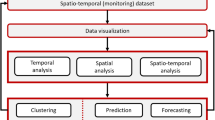Abstract
Environmental applications share common features that make them distinct from typical applications of other areas of applied computer science. This fact has lead during the last years to the development of Environmental Informatics, a novel specialty of Applied Informatics, which studies specific problems related with the application of computer science techniques in environmental problems. In environmental applications often many different, non homogeneous information sources can be found, such as text data e.g. environmental legislation or research projects results, measurement data from monitoring networks, structural data on chemical substances, satellite data etc. In particular, environmental data is often geographically coded, i.e. information is attached to a particular point or region in space. Secondly, some of the data objects are multidimensional and have to be represented by means of complex geometric objects (polygons or curves).
Preview
Unable to display preview. Download preview PDF.
Similar content being viewed by others
References
N. Avouris, B. Page, Environmental Informatics, Introduction, Kluwer Academic Publishers, pp. ix, 1995.
J.A. Benediktsson, K. Arnason, Fusion and Classification of Multitype Data. In [13].
J. Carlos Ferreira da Rocha, D. L. Borges, C.A.A. Kaestner, Bayesian Networks for Change Analysis in Environmental Monitoring. In [13].
V. Demyanov, N. Gilardi, M. Kanevski, M. Maignan, V. Polishchuk, Decision-Oriented Environmental Mapping with Radial Basis Function Neural Networks. In [13].
N. Gilardi, M. Kanevski, M. Maignan, E. Mayoraz, Environmental and Pollution Data Classification with support vector machines and Geostatistics. In [13].
D. Grosser, N. Conruyt, Tree-based classification approach for dealing with complex knowledge in natural sciences. In [13].
L.M. Hilty, B. Page, F.J. Radermacher, W.-F. Riekert, Environmental Informatics as a New Discipline of Applied Computer Science, in Environmental Informatics (N. Avouris, B. Page editors), Kluwer Academic Publishers, 1995.
E. Kalapanidas, N. Avouris, Machine Learning Techniques for Air Quality Prediction. In [13].
H. Toivonen, K. Vasko, H. Mannila, A. Korhola, H. Olander, Bayesian modeling in paleoenvironmental reconstruction. In [13].
C. Tsatsoulis, Leen-Kiat Soh, Cheryl Bertoia, Kim Partington, Intelligent Fusion of Multisource Data for Sea Ice Classification. In [13].
G. Tsoumakas and I. Vlahavas, ISLE: An Intelligent System for Land Evaluation. In [13].
N. Vassilas, S. Perantonis, E. Charou, K. Seretis and Th. Tsenoglou Automatic Lineament Detection from Geophysical Grid Data Using Efficient Clustering and Weighted Hough Transform Algorithms. In [13].
Proceedings of the Workshop on Intelligent Techniques for Spatio-Temporal Data Analysis in Environmental Applications, Advanced Course on Artificial Intelligence (ACAI’ 99), Chania, Greece, 1999 http://www.iit.demokritos.gr/skel/eetn/acai99/Workshops.htm).
Author information
Authors and Affiliations
Editor information
Editors and Affiliations
Rights and permissions
Copyright information
© 2001 Springer-Verlag Berlin Heidelberg
About this chapter
Cite this chapter
Vassilas, N., Kalapanidas, E., Avouris, N., Perantonis, S. (2001). Intelligent Techniques for Spatio-Temporal Data Analysis in Environmental Applications. In: Paliouras, G., Karkaletsis, V., Spyropoulos, C.D. (eds) Machine Learning and Its Applications. ACAI 1999. Lecture Notes in Computer Science(), vol 2049. Springer, Berlin, Heidelberg. https://doi.org/10.1007/3-540-44673-7_21
Download citation
DOI: https://doi.org/10.1007/3-540-44673-7_21
Published:
Publisher Name: Springer, Berlin, Heidelberg
Print ISBN: 978-3-540-42490-1
Online ISBN: 978-3-540-44673-6
eBook Packages: Springer Book Archive




